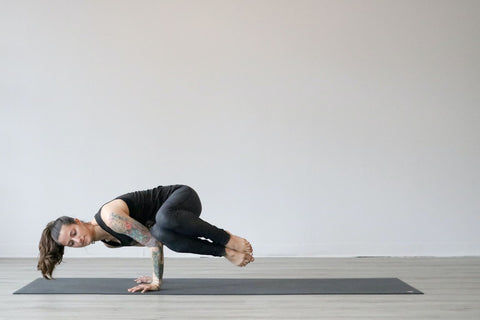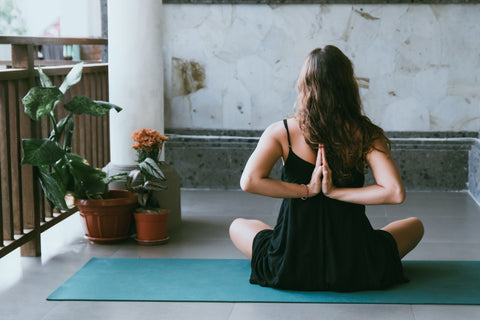Whether it’s from exercise, heavy lifting, or sleeping uncomfortably, back pain is something many of us have experienced. At minimum it can be distracting, even debilitating as it causes a lot of pain and loss of rejuvenating sleep. Understanding how yoga helps relieve and even heal back pain can help you get the most from your practice!
Our muscles support our bones to prevent injury to them. They also support other systems in our bodies, such as our blood flow, digestion, and breathing. All of this is connected by a single system, the central nervous system, which is housed by the spine. The spine protects the central nervous system, and in turn, there are muscles to protect the spine, which are located in the chest, abs, back, and legs. This is quite a wide area, but it all works together to support the spine and thus the back. Yoga can teach proper posture and movement, and for more advanced students can enhance flexibility and concentration. All of these things can reduce back pain and even prevent back injury. Here are five ways yoga can be used to accomplish all of it!
1. Build Strength!
For most of us, back pain is a direct result of muscle tension of some sort, both in your back and the muscles that support your back (such as your abs or hamstrings). Yoga poses, or asanas, used in conjunction with its movements, help strengthen the back by gently building up the muscles that support the spine. Yoga is a gentle self-application of muscle tension designed to condition muscles for more physical endurance (which we call “strength”). As a result, yoga strengthens the back without causing pain for the practitioner.
2. Concentration Protects Muscles
Since yoga requires concentration, yoga practitioners learn how they move and what they can handle. Repeated yoga over a period of time ingrains the knowledge of these muscles into your habitual movement, and this helps maintain good posture and move fluidly. Bad posture causes back pain by putting strain on our muscles, and movement that is jerky or uncoordinated can cause injuries in the form of strains and sprains.
Concentrating on the postures and movements of yoga teaches us how to move properly and protect our muscles, including those which support the spine. The added benefit of practicing yoga regularly is that this concentration becomes ingrained in your subconscious, so you wind up eventually having good posture and movement without being consciously aware of it. (Another benefit to this aspect of yoga is that it enhances your overall concentration, too!)
3. Stretch Out!
In a study conducted in 2011 and published in the Archive of Internal Medicine, yoga was held up against conventional stretching classes and another group guided by a book. The purpose of the study was to examine the success rate of yoga’s effects on lower back pain. The results are clear --guided stretching exercises definitely help reduce lower back pain, in large part because they help blood circulate properly through the body, where it is infused into the muscles and brain. Many conventional stretches are similar to yoga, except that they lack the concentration component that makes yoga relaxing and stress-relieving. Since yoga is so popular, books about it teach a more precise method than conventional stretching, as well as the breathing and meditation that makes yoga unique.
4. Breathe In Oxygen
Staggered or systematic breathing is called Pranayama in Sanskrit, which means “controlled life force” (prana means “life force,” which was believed to have come from the breath; ayama means “control” or “extension”). The same yogis whose observations about our bodies developed yoga also made observations about breathing and its effects on the body.
Today we know that the oxygen we breathe in enriches the blood and thus gives our bodies energy. This oxygenated blood also goes through our muscles and even our brains, releasing tension and repairing damage. Pranayama is entwined with yoga in that it is an important part of the practice. Another benefit besides helping with back pain is an increase in breathing capacity in general.
5. Relaxation
Stress is a throwback from millennia ago when everyday stress might include wild animals trying to eat us, but today it might be caused by any number of factors, from lack of sleep to slow traffic to burning food while cooking. The myriad of everyday stresses we face adds up and causes us to go into “fight or flight” mode (called the sympathetic nervous system), unconsciously raising the heartbeat and breathing rate, shutting down hunger, and tensing the muscles.
Being in this state for long periods of time (as many of us are) can wear down the body and cause all manner of illnesses, many of which contribute to back pain as the central nervous system works overtime to keep us alert. In our breathing, our awareness of our bodies, and our stretching and strengthening of muscles, yoga helps relieve stress in a variety of significant ways. It helps activate the counter to “fight or flight,” called the parasympathetic nervous system, which helps the body relax after the adrenaline and tenseness of being under stress. Much of our lifestyles can activate the sympathetic nervous system, and knowing yoga techniques is almost like having an “on-off” switch for it, and by extension, stress!
Back pain is a horrible experience, but yoga can alleviate it in so many ways. By helping us be more graceful, more fluid, and more aware of our bodies, we can alleviate back pain we have as well as prevent future injuries. By breathing and relaxing, we can reduce stress that causes back pain and makes us too weary to exercise properly. Long-term yoga practice can help sustain a healthy back by establishing habits, both conscious and unconscious, which can last a lifetime!









